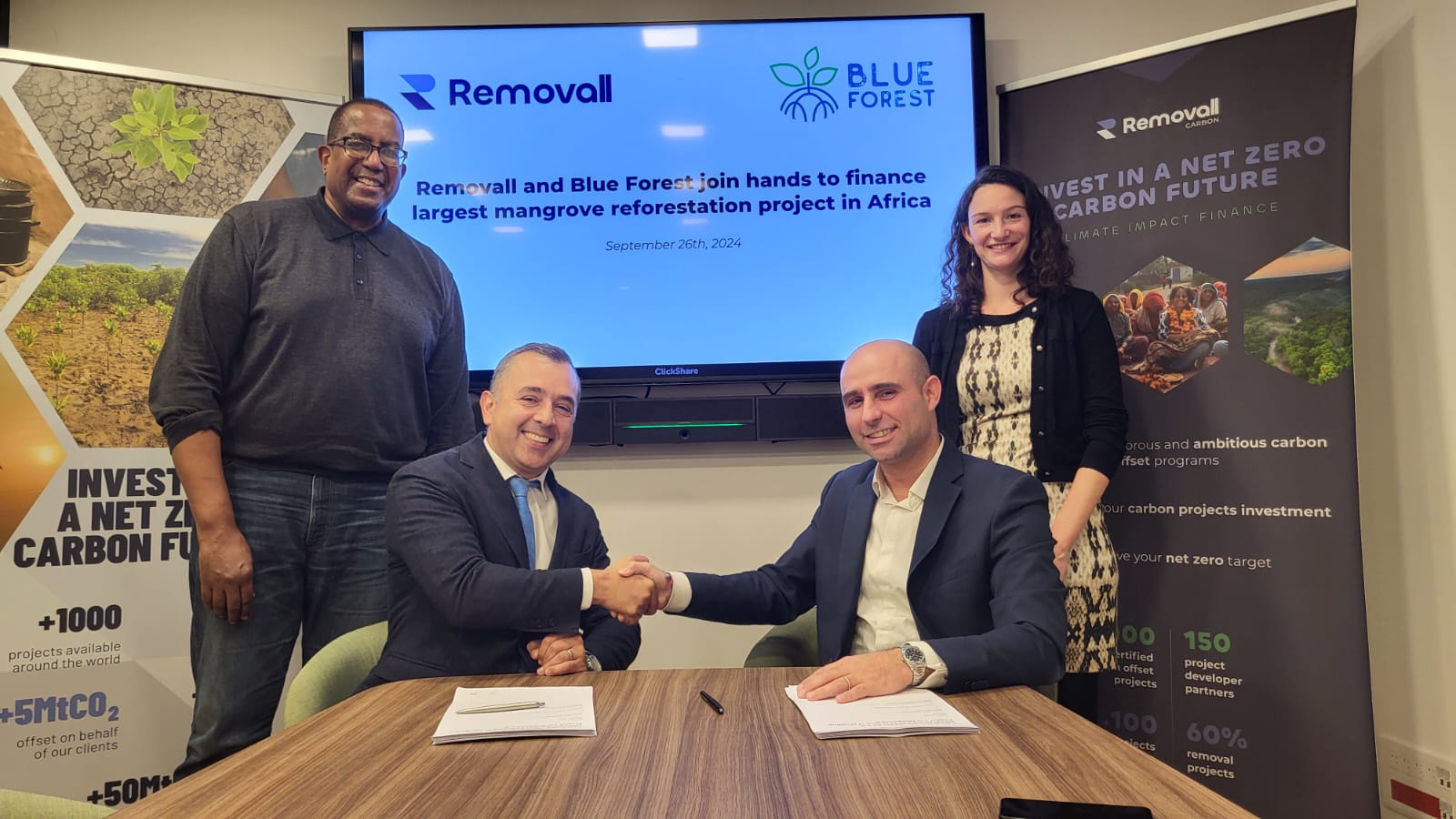Updated Overview of Mangroves Worldwide
The State of the World’s Mangroves in 2024
A Review of the Global Mangrove Alliance Report
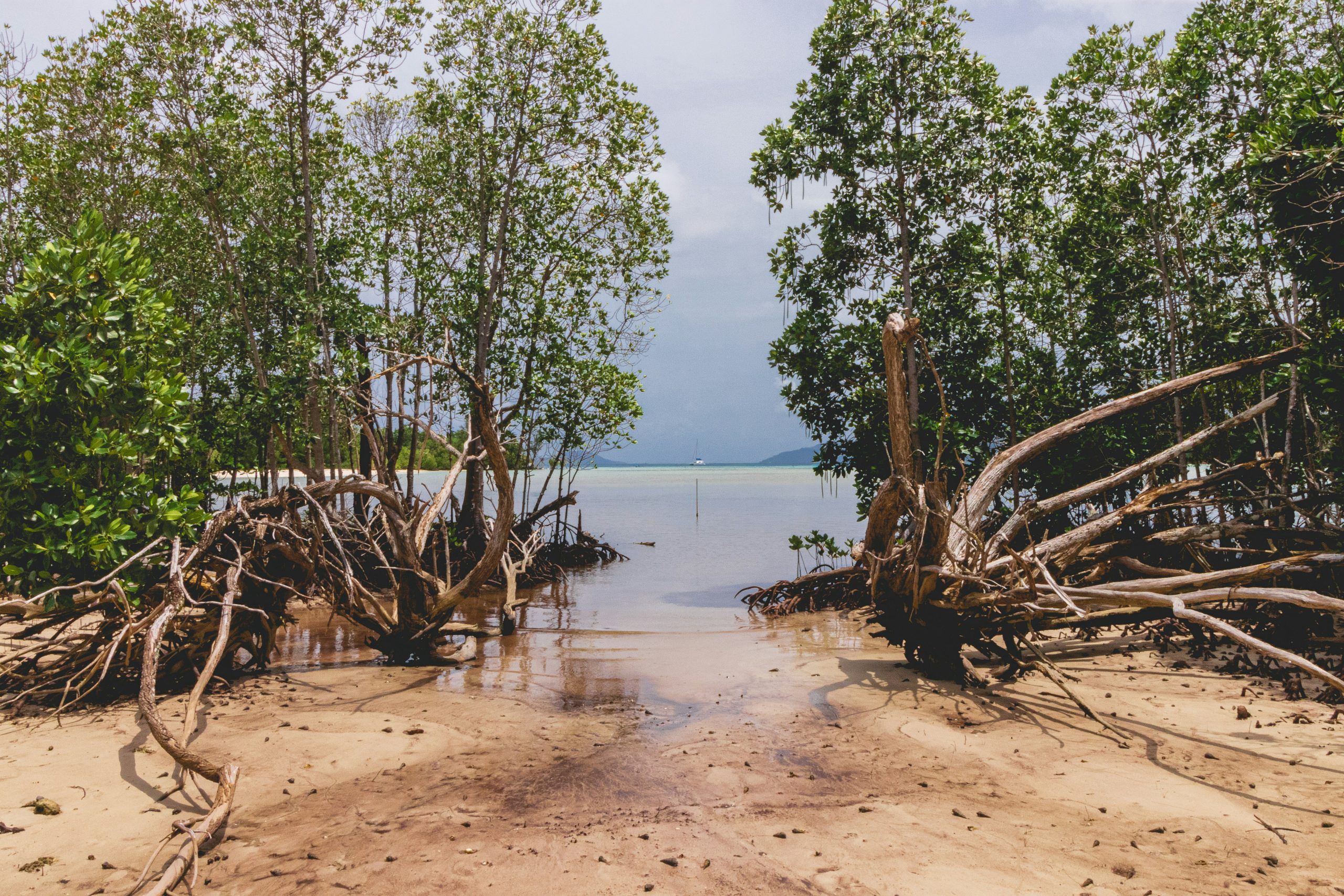
This article provides a detailed review of the report The State of the World’s Mangroves 2024, published by the Global Mangrove Alliance (GMA). Mangroves, ecosystems bridging land and sea, are vital for biodiversity, climate resilience, and human livelihoods. Despite their importance, they face mounting threats from climate change and human activities. The GMA report highlights key advances in mapping and protecting mangroves while addressing ongoing challenges and outlining future strategies. This article is structured into five main sections:
Key Drivers of Mangrove Losses
Expansion of Mangroves
Utility of Mangroves
Updated Overview of Mangroves Worldwide
Improved mapping techniques in 2024 have provided a more precise assessment of the extent and distribution of mangroves globally. While the first global maps of mangrove forests were generated in 1997, the fourth iteration of the Global Mangrove Watch (GMW v4.0), released in 2024, employs 10-meter resolution mapping, a sixfold improvement over previous versions, with an accuracy rate of 95.3%. This dataset maps 14 million hectares (147,256 km²) of mangroves worldwide, spanning 128 countries.
Key regional insights:
- Southeast Asia leads with 33.6% of the global mangrove area, with Indonesia alone hosting 21%.
- The Americas account for 27.8%, Africa 20.8%, and Oceania 10.9%.
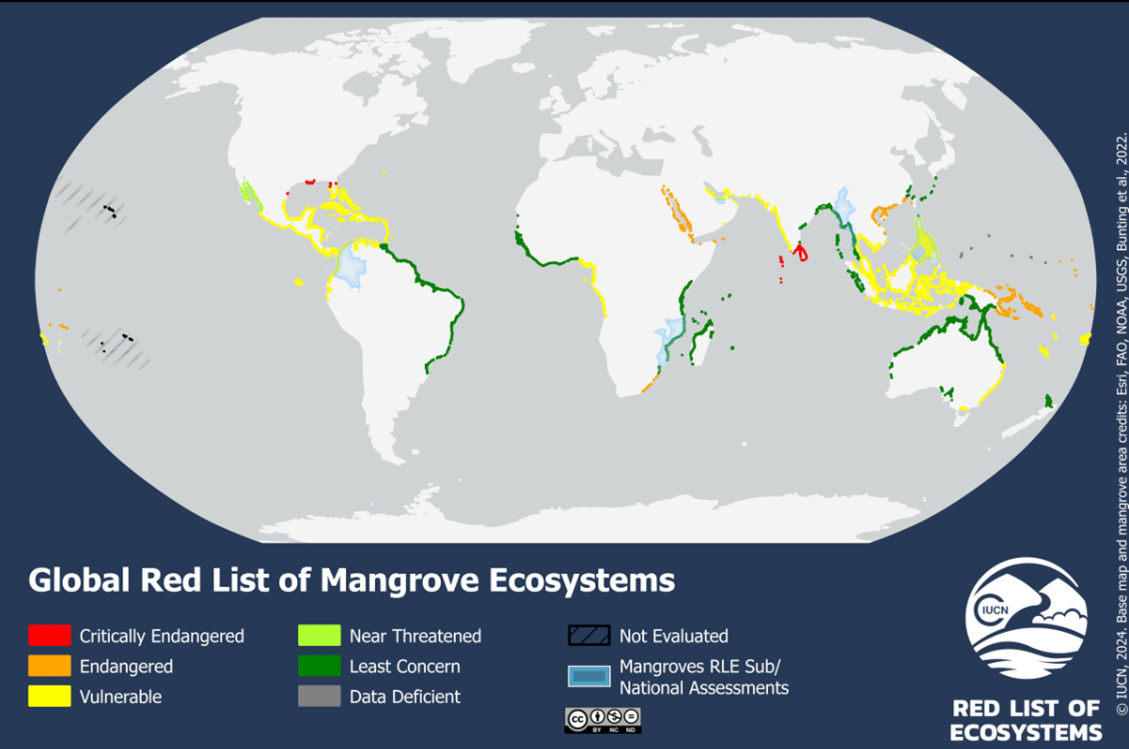
The international NGO International Union for Conservation of Nature (IUCN) has established a Global Red List of Mangrove Ecosystems, which identifies mangrove ecosystems at risk globally, and is depicted on the map below:
Key Drivers of Mangrove Losses
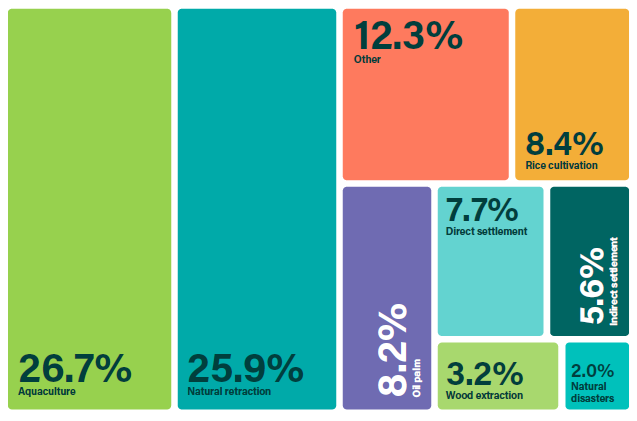
Global drivers of mangrove loss, 2000-2020 (Source: the Food and Agriculture Organization of the United Nations, 2023, The world's mangroves 2000-2020)
Human Activities (43% of global loss): Over the last twenty years, activities like aquaculture (26.7%), rice cultivation (8.4%) and oil palm plantations (8.2%) were major contributors to global mangrove losses.
Natural Retraction (26% of global loss): The term “natural retraction” is used to cover changes or losses of mangroves that are driven by movements in riverbeds, sediment inputs, or sea levels. Oceania experienced the most extensive natural retraction, accounting for 90% of its mangrove decline.
Trends Over Time:
Comparing the two periods 2000-2010 and 2010-2020:
- Aquaculture remains a key driver, but its significance diminished, causing about 31% of loss in 2000–2010, compared to 21% in 2010–2020.
- The significance of rice cultivation and direct settlement (conversion to buildings and infrastructure) as drivers of mangrove loss also declined markedly (from 24% to 5%).
- On the other hand, conversion to oil palm plantations became a substantially bigger driver (causing about 4% loss in 2000–2010, but 14% in 2010–2020).
- Natural retraction’s contribution rose from 24% to 29%, partly due to intensified climate change impacts.
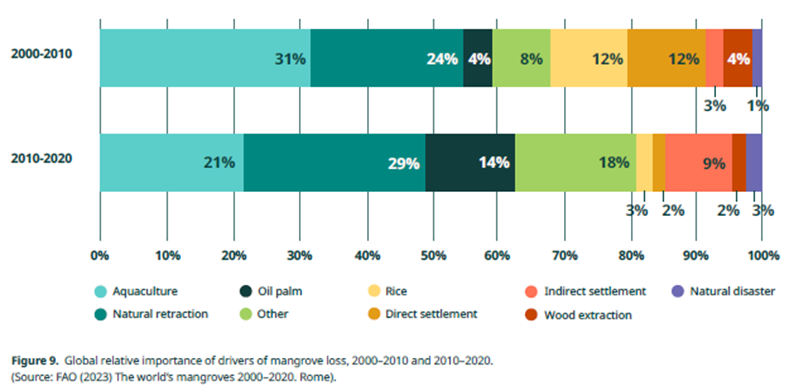
Regional Variations:
- Human-induced activities dominate in Asia (aquaculture, rice, oil palm) and Africa (direct settlements, agricultural activities, aquaculture), highlighting local socio-economic pressures.
- Natural threats are prevalent in South America and Oceania.
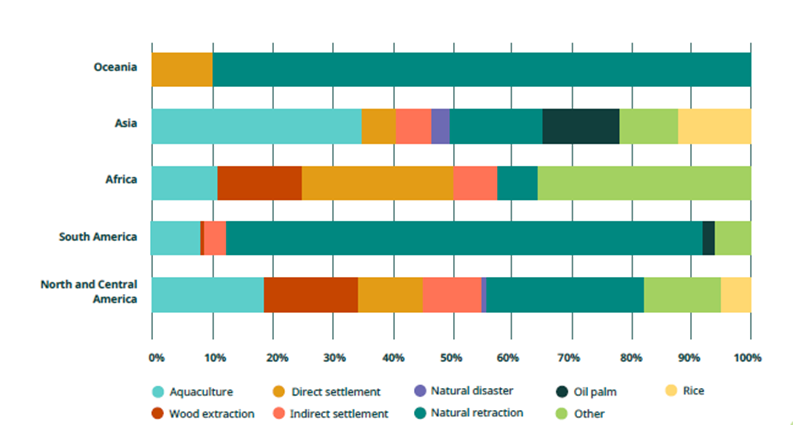
Expansion of Mangroves:
Despite losses, more than half of the total mangrove decline (6,769 km²) between 2000 and 2020 was offset by mangrove expansion, resulting in a net decline of “only” 2,839 km².
- Natural expansion accounted for 82% of global gains, showcasing mangroves’ natural resilience to environmental changes. Given the increasing impacts of climate change, it might be expected that natural retraction would outpace natural expansion. It is actually the opposite, and natural expansion greatly exceeded mangrove loss due to natural retraction. It illustrates the difficulty of predicting the effects of climate change on mangrove communities given the complex interplay between local biophysical conditions and the consequences of global warming.
- Restoration efforts contributed 18% of the gains, with significant success in Southeast Asia (25%) and Africa (33%).
Utility of Mangroves
Carbon Storage:
- Mangroves store an average of 394 tonnes of carbon per hectare, with 78% in soil, 15% in aboveground biomass, and 7% in belowground biomass.
- There is considerable variation across regions: Southeast Asia, particularly the Philippines, has the highest carbon densities (above 650 tonnes/ha), while the Middle East has the lowest (below 100 tonnes/ha). The differences are illustrated in the map below:
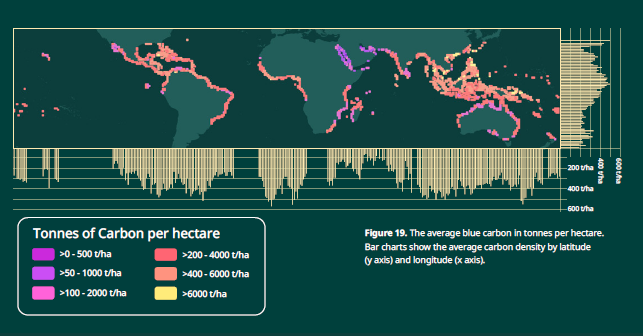
Coastal Protection:
- Mangroves reduce flood depth by 15-20%. Their dense root systems dissipate wave energy, safeguarding coastal communities from flooding and erosion.
Biodiversity:
- Mangroves are home to 70 species of mangrove trees, among which the most well-known are Avicennia, Bruguiera, Ceriops, Rhizophora and Sonneratia, with 16% under elevated threat of extinction.
- Worldwide, a significant number of species are endemic to mangroves, including 48 birds, 14 reptiles, one amphibian, and six mammals. 40% of these are threatened with extinction.
- Indian mangroves in the Sundurbans have the highest record of biodiversity, supporting over 5,700 plant and animal species.
Food Security:
- Mangroves support nearly 800 billion young fish, prawns, and crabs annually. Across the world, millions of people rely on the protein and micronutrients provided by mangrove coastal fisheries.
- Beyond fisheries, mangroves offer resources like honey, fruits, medicinal plants, livestock fodder, fuelwood and charcoal, contributing to diverse livelihoods in coastal regions.
- Shrimp ponds have deforested huge surface of mangroves in the 1970s. A 2018 study estimated that there are 250,000 ha of abandoned shrimp ponds in Indonesia alone. The challenges of returning shrimp ponds to mangroves can be significant, but groups such as the Mangrove Action Project have developed highly effective approaches.
Conservation and Restoration Efforts
Guidelines and Best Practices:
In 2023, the GMA and the Blue Carbon Initiative launched the Best Practice Guidelines for Mangrove Restoration. The Guidelines were developed to provide project managers, investors, and policymakers with a step-by-step approach for every phase of the project cycle, from project design and funding to implementation. The guidelines emphasize for example on the following restoration best practice:
- Understand the ecosystem services of mangroves. Within the coastal zone, mangroves form a complex mosaic with adjacent ecosystems, such as tidal marshes, seagrass meadows, tidal flats, and coral reefs. As such, it is often difficult to fully determine where one ecosystem starts and another ends. Many efforts at mangrove restoration have been misguidedly placed in some of these adjacent ecosystems, notably on tidal flats and shallow seagrass systems, where tidal flooding prevents the natural establishment of mangrove trees. Such efforts are often unsuccessful with low survival rates of seedlings, and they can also damage these valuable adjacent ecosystems. Mangrove conservation and restoration activities need to ensure that ecosystems adjacent to mangroves are incorporated into projects. This will require thinking more holistically about conserving multiple ecosystems and their connectivity across the seascape.
- Connect with Local Ecological Knowledge and traditional knowledge of Indigenous groups.
- Focus on Integrated mangrove aquaculture (IMA). IMA involves the restoration of mangroves within ponds and embankments of farms. In fact, IMA or Sustainable Aquaculture in Mangrove Ecosystems (SAIME) is the aquatic version of agroforestry on land, where food is grown and harvested within a functional ecosystem. Depending on the site conditions and the overall setup of the ponds and hydraulic dynamics, IMA ideally involves the restoration of at least 50% of the total surface of a given farm with mangroves. The trees become the main driver for productivity, generating seafood for harvesting, while creating economic incentives for farmers to restore and maintain mangroves. IMA usually involves a polyculture approach where farmers grow multiple species of shrimp, crab, filter-feeding fish, and bivalve mollusks.
Protection Goals:
- The GMA aims to double mangrove protection by 2030. Currently, 40% of mangroves are in protected areas. While countries like Brazil, Mexico, and Bangladesh protect over 75% of their mangroves, Malaysia and Papua New Guinea protect less than 5%.
Conferences and Financing Initiatives:
- At COP28, global commitments targeted restoring 15 million hectares of mangroves by 2030, with sustainable financing of US$4 billion through the Mangrove Breakthrough initiative.
- The 2025 COP 30 will convene in November 2025 in Brazil, with nature and IPLCs (Indigenous peoples and local communities) high on the agenda. The GMA, with partners of the Mangrove Breakthrough, plans to promote the key role of mangroves for climate action by leveraging its expansive network and expertise in advocating for mangrove conservation and restoration and garnering enhanced climate pledges.
Conclusion
The State of the World’s Mangroves 2024 report underscores significant progress in mangrove conservation while highlighting ongoing challenges. Mangroves are indispensable for global climate resilience, biodiversity, and livelihoods. However, there remains untapped potential for mangrove carbon projects to generate carbon credits.
At Removall, we are committed to restoring and conserving mangroves. We have already invested in large-scale projects, including a 5,000-hectare restoration initiative in the Zambezi Delta, Zambézia region, Mozambique, which follows the Verified Carbon Standard (VCS) with dual CCB certification* under the VM0033 mangrove methodology. Additionally, we are supporting a conservation project in Myanmar, also certified under VCS, aimed at protecting and enhancing the region’s mangrove ecosystems. Beyond these efforts, we are actively developing new mangrove projects in other countries, including Tanzania and India, to further scale up our impact on blue carbon conservation and restoration.
* The CCB Standards are meant for land use projects (afforestation, reforestation, REDD, agriculture etc.). Project developers are required to have thorough understanding of the project area and drivers of change. To be eligible under the CCB Standards, a project must have specific and measurable climate, community, and biodiversity objectives, and demonstrate impact in all three areas. A project must involve communities and stakeholders thourgh full and effective participation.
Source : www.verra.org
Article written by :

Head of Investment
